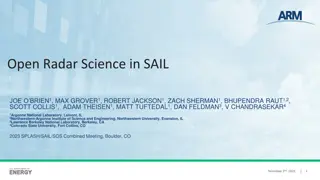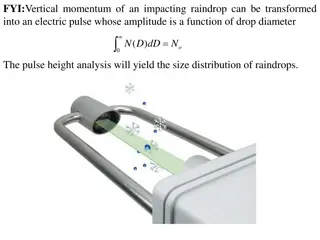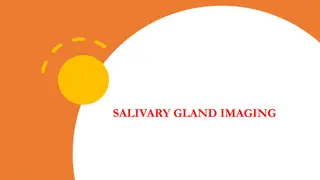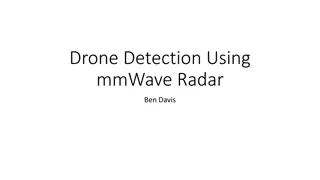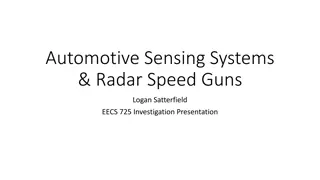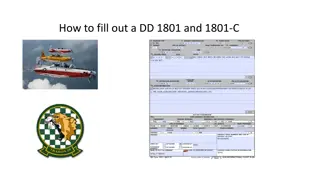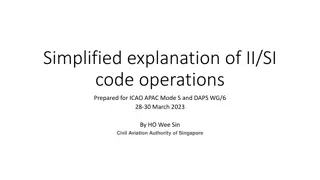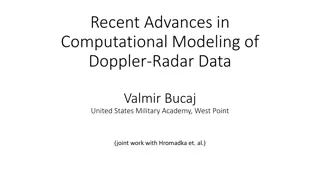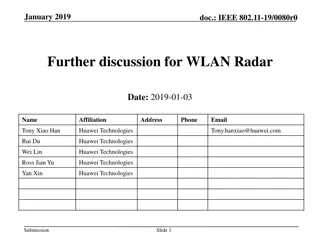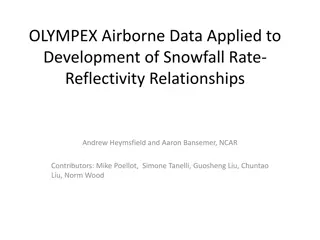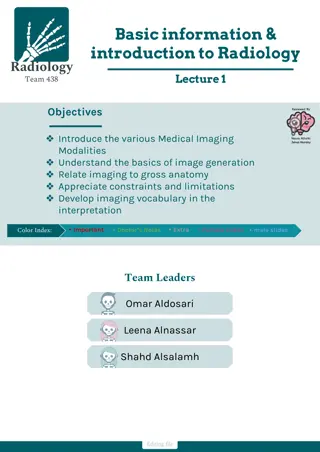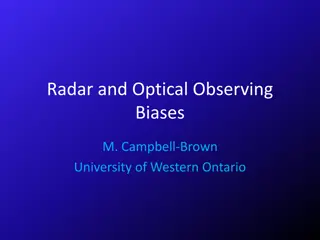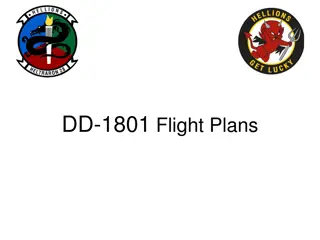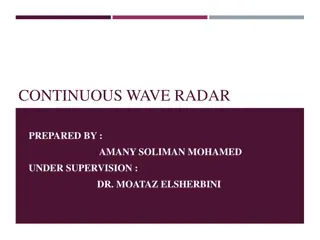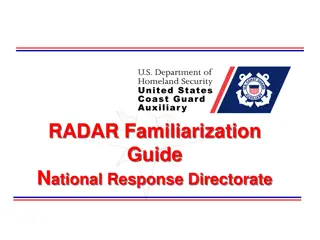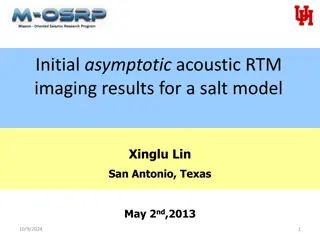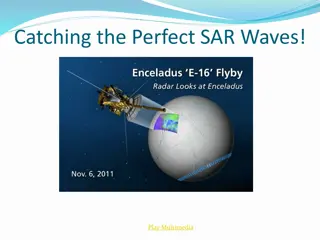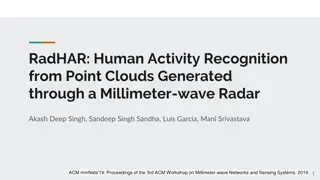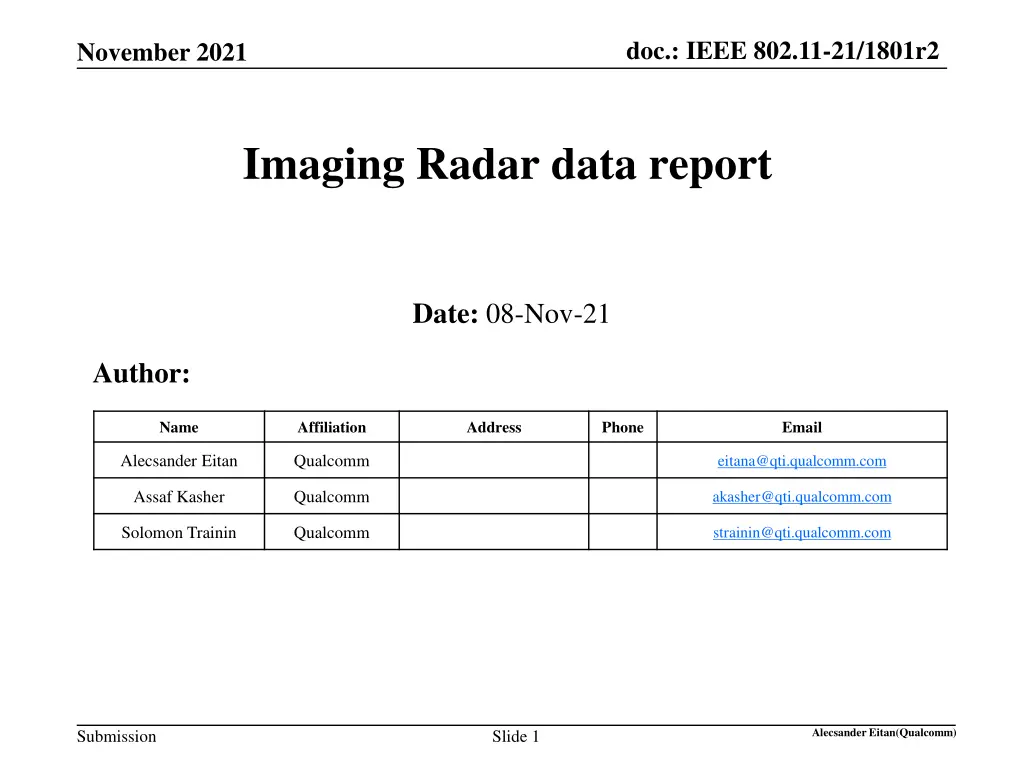
Advanced Imaging Radar Data Analysis
Discover the latest in Imaging Radar technology with this comprehensive report from November 2021, outlining processing methods, data visualization, and practical applications. Dive into the world of Doppler FFT, target detection, and tracking, and explore the complexities of 2D, 3D, and 4D imaging. Gain insights into data snapshots and understand the challenges and opportunities in this innovative field.
Download Presentation

Please find below an Image/Link to download the presentation.
The content on the website is provided AS IS for your information and personal use only. It may not be sold, licensed, or shared on other websites without obtaining consent from the author. If you encounter any issues during the download, it is possible that the publisher has removed the file from their server.
You are allowed to download the files provided on this website for personal or commercial use, subject to the condition that they are used lawfully. All files are the property of their respective owners.
The content on the website is provided AS IS for your information and personal use only. It may not be sold, licensed, or shared on other websites without obtaining consent from the author.
E N D
Presentation Transcript
doc.: IEEE 802.11-21/1801r2 November 2021 Imaging Radar data report Date: 08-Nov-21 Author: Name Affiliation Address Phone Email Alecsander Eitan Qualcomm eitana@qti.qualcomm.com Assaf Kasher Qualcomm akasher@qti.qualcomm.com Solomon Trainin Qualcomm strainin@qti.qualcomm.com Alecsander Eitan(Qualcomm) Submission Slide 1
doc.: IEEE 802.11-21/1801r2 November 2021 Agenda This presentation introduces the Imaging Radar We present the typical processing of an Imaging Radar Discuss the report options and evaluate them Submission Slide 2 Alecsander Eitan(Qualcomm))
doc.: IEEE 802.11-21/1801r2 November 2021 Imaging Radar Imaging Radar provides image of the scene The image is: 2D (Az, Range or Az, El or Range, Doppler) 3D (Az, El, Range or Az, Range, Doppler) 4D (Az, El, Range, Doppler) Typical Imaging Radar processing block diagram Doppler FFT Target Detection & Tracking ADC Correlator Az & El CFAR Notes: 2D is a two-dimensional data, 3D is a three-dimensional data and 4D is a four-dimensional data Az and El are Azimuth and Elevation CFAR is - Constant False Alarm Rate . CFAR detection refers to a common form of adaptive algorithm used in radar systems to detect target returns against a background of noise, clutter and interference) Submission Slide 3 Alecsander Eitan(Qualcomm)
doc.: IEEE 802.11-21/1801r2 November 2021 Imaging Radar Data Doppler FFT Target Detection & Tracking ADC Correlator Az & El CFAR Time Domain 2D/3D/4D Map 2D/3D/4D Filtered Map Targets Submission Slide 4 Alecsander Eitan(Qualcomm)
doc.: IEEE 802.11-21/1801r2 November 2021 Imaging Radar Data Submission Slide 5 Alecsander Eitan(Qualcomm)
doc.: IEEE 802.11-21/1801r2 November 2021 Imaging Radar Data Snapshot from a nice video from NXP Submission Slide 6 Alecsander Eitan(Qualcomm)
doc.: IEEE 802.11-21/1801r2 November 2021 Imaging Radar Data Doppler FFT Target Detection & Tracking ADC Correlator Az & El CFAR Time Domain 2D/3D/4D Map 2D/3D/4D Filtered Map Targets Time Domain (CSI): 24 bit per sample -> Huge size (12x2xTmeas) 2D/3D/4D: -> Huge size 2D/3D/4D Filtered: -> Large size Targets: -> Compact Submission Slide 7 Alecsander Eitan(Qualcomm)
doc.: IEEE 802.11-21/1801r2 November 2021 Conclusions Reporting Time-domain data is very ineffective for imaging Radar, and requires the recipient to perform processing, like AoA (which requires knowledge known only at the receiver) Reporting Unfiltered 2D/3D/4D map is very ineffective for imaging Radar. Reporting Filtered 2D/3D/4D map is practical Reporting Targets is the most efficient method Submission Slide 8 Alecsander Eitan(Qualcomm)
doc.: IEEE 802.11-21/1801r2 November 2021 SP #1 Do you agree to add the following to 11bf SFD: The 11bf amendment shall define one or more report methods for 2D, 3D and 4D filtered maps. SP results (Nov 23 2021): 8/4/21 Submission Slide 9 Alecsander Eitan(Qualcomm)
doc.: IEEE 802.11-21/1801r2 November 2021 Motion #1 Move to add the following to the TGbf SFD: The 11bf amendment shall define at least one measurement report type for 2D, 3D and 4D filtered maps, for DMG/EDMG. This measurement report type is an optional feature. Supporting 2D, 3D and 4D are each optional feature The details of the measurement report format is TBD 2D is a two-dimensional map, where the two dimensions are any from: Range, Azimuth, Elevation & Doppler. 3D is a three-dimensional map, where the three dimensions are any from: Range, Azimuth, Elevation & Doppler. 4D is a four-dimensional map, where the four dimensions are: Range, Azimuth, Elevation & Doppler. Submission Slide 10 Alecsander Eitan(Qualcomm)
doc.: IEEE 802.11-21/1801r2 November 2021 SP #2 Do you agree to add the following to 11bf SFD: The 11bf amendment shall define one or more report methods for targets. ( Target is a detected object. e.g. with a 3D size and specific doppler) SP results (Nov 23 2021): 8/10/16 Submission Slide 11 Alecsander Eitan(Qualcomm)
doc.: IEEE 802.11-21/1801r2 November 2021 Motion #2 Move to add the following to the TGbf SFD: The 11bf amendment shall define at least one measurement report type for targets, for DMG/EDMG. ( Target is a detected object) This measurement report type is an optional feature. The details of the measurement report format is TBD Submission Slide 12 Alecsander Eitan(Qualcomm)

